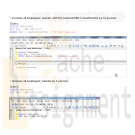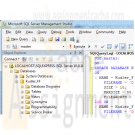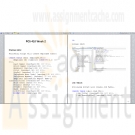POS410 Sql For Business
POS410 - Sql For Business Assignment
POS410 Sql For Business covers Structured Query Language (SQL) that provides a unified language that lets you query, manipulate, or control data in a business applications environment.
-

POS 410 Week 4 SQL for Business Kudler_FF database
$15.00POS/410 SQL for Business Week 4
SQL Reports
Use tables from the Kudler_FF database to write the SQL statements necessary to perform the following data manipulation:
o Increase all employees salaries with the selected EEO-1 classification by 10%.
o Increase all employees salaries by 5%.
o Choose an employee from the Employee table and delete that employee.
Deliverable: Copy the SQL statements and data from both tables showing how data was affected to a Word document. Post the document to the assignment tab of the classroom.
Use tables from the Kudler_FF database to write SQL statements that perform the following computations:
o Calculate the average salary for all employees.
o Calculate the maximum salary for all employees.
o Calculate the maximum salary for exempt employees.
o Calculate the minimum salary for all employees.
o Calculate the minimum salary for non-exempt employees.
Deliverable: Copy the SQL statements and results to a Word document. Post the document to the assignment tab of the classroom.
Learn More
Use tables from the Kudler_FF database to write the following queries, using the GROUP BY clause in your SQL statements:
o Count the number of employees, grouped by EEO classification.
o Count the number of employees, grouped by exemption status.
o Compute the average salary, grouped by area code and gender.
o Compute average age, grouped by exemption status o Compute the earliest hire date, grouped area code, gender, and exemption status. Deliverable: Copy the SQL statements and results to a Word document. Post the document to the assignment tab of the classroom. -

POS 410 Week 1 SQL for Business Individual SQL Tables
$12.00POS 410 Week 1 SQL for Business Individual: SQL Tables
Create an SQL Server database for the Kudler Fine Foods Virtual Organization.
Reference Chapter 5 of this week’s reading material for the instructions and command (create database) that is needed to create the database.
Database Recommendations (Hint: you will need to create the pos410 subdirectory on the D drive of the Toolwire desktop before the Create Database command can be successfully executed using these specifications.)
Database Name: Kudler_FF
Logical File Name: Kudler_FF
Database File Name: D:\pos410\Kudler_FF.mdf
Database Size: 10
Database Max Size: 50
Database Growth: 5
Logical Log Name: Kudler_FF_Log
Log File Name: D:\pos410\Kudler_FF_Log.ldf
Log Size: 5
Log Max Size: 25
Log Growth 5NOTE: The database will not be needed until you start building the tables for week 2, but the sooner the database is built the better. Waiting until the second week to start building your database could result in week 2 assignments submitted late, due to the work involved in building the database.
Learn More -

POS 410 Week 2 Table Queries SQL for Business
$12.00POS 410 Week 2 Table Queries SQL for Business
Learn More
Create two tables using the specifications listed.
• Use the database built in last week’s assignment to create the two tables and associated columns listed below. Table names, data types, and column lengths must be used as specified; column names may be created as desired and appropriate. Avoiding the use of spaces and special characters in the column names is recommended.
• In the Employee table, create an Employee ID column that generates a unique number for each employee and designate the column as the Primary Key. In the Job table, use the job title column as the table’s primary key.
Table Name = Employee_Tbl
• Employee ID (type= numeric identity) PK
• Last name (type=varchar(30))
• First name (type=varchar(30))
• Address (type=varchar(30))
• City (type=varchar(30))
• State (type=varchar(2))
• Telephone area code (type=varchar(3))
• Telephone number (type=varchar(7))
• Employer Information Report (EEO-1) classification (type=varchar(30))
• Hire date (type=date)
• Salary (type=money)
• Gender (type=varchar(1))
• Age (type=numeric)
• Job Title (type=varchar(30))
Table Name = Job_Tbl
• Job title (type=varchar(30)) PK
• Job description (type=varchar(2000))
• Exemption status (type=varchar(1))
Use the SQL INSERT statement to go to the human resources department in the Kudler Fine Foods Virtual Organization. Using information found in the employee files for the La Jolla and Encinitas stores, enter records into the Employee table for the following employees:
• Glenn Edelman
• Eric McMullen
• Raj Slentz
• Erin Broun
• Donald Carpenter
• David Esquivez
• Nancy Sharp
Use the information from the job classifications and descriptions to enter records into the Job Title table for the following titles:
• Accounting clerk
• Assistant manager
• Bagger
• Cashier
• Computer support specialist
• Director of finance and accounting
• Retail assistant bakery and pastry
• Retail assistant butchers and seafood specialists
• Stocker
Hint: Data entered into the job title column of the employee_tbl and job_tbl tables must match exactly, including case, spaces, and so on. If they do not match exactly, you will not be able to create the foreign key or perform the joins that are required in later assignments.
Deliverables: check your results by selecting all of the data from both tables (one table at a time). Copy and paste screen images of your work in a word doc, then post as an attachment in your assignment tab of the classroom. You may need to resize your windows and take multiple screen shots to capture all of the required information. The screen images should show the following information:
• Database, table, and column definitions
• SQL statements used to load the data
• Data stored in both tables (display contents after data is loaded)
Refer to the materials forum for the rubric that will be used to grade this assignment. -

POS 410 Week 3 Data Changes and SQL Statements SQL for Business
$12.00POS 410 Week 3 Data Changes and SQL Statements SQL for Business
Learn More
Use the Kudler_FF database to build a foreign key. The foreign key should be built on the job title column in the employee_tbl, which references the job title column in the job_tbl. An “alter table” statement will be required to build this FK on the employee_tbl.
Deliverable: Copy (screen image) the SQL statement used to build the foreign key and the associated output message from its execution into a Word document and post them to the assignment tab of the classroom.
Use the Kudler_FF database to write SQL statements and enter records into the Employee table for workers identified in the employee files for the administrative offices and the DelMar store. Check results by selecting all columns from both tables.
Deliverable: Copy (screen image) the SQL used to check your results and the output to a Word document and post to the assignment tab of the classroom.
Use the tables in the Kudler_FF database to write the following SQL queries:
o Write a SQL query that joins the two tables in the Kudler_FF database, and displays the Employee Last Name, First Name, Hire Date, Area Code, Job Title, and Exemption Status.
o Write a SQL query that joins the two tables in the Kudler_FF database and uses BETWEEN to restrict record selection; use hire dates to restrict data.
o Write a SQL query that joins the two tables in the Kudler_FF database and uses LIKE to restrict record selection; use telephone area codes to restrict data.
o Write a SQL query that joins the two tables in the Kudler_FF database, and restricts the record selection to an exemption status.
o Write a SQL query that uses the UNION of the two tables to produce the results set
Deliverable: Copy (screen image) each query and the results set to a Word document and post them to the assignment tab of the classroom.
Refer to the materials forum for the rubric that will be used to grade this assignment.




